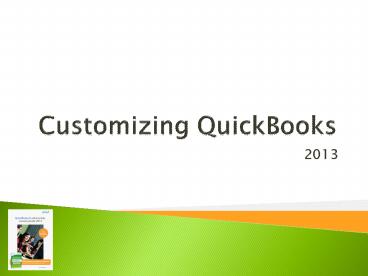Customizing QuickBooks
Title:
Customizing QuickBooks
Description:
Title: Chapter 7 Customizing QuickBooks Author: The Sleeter Group, Inc. Last modified by: Deborah Created Date: 6/8/2004 5:25:39 PM Document presentation format – PowerPoint PPT presentation
Number of Views:7
Avg rating:3.0/5.0
Title: Customizing QuickBooks
1
Customizing QuickBooks
- 2013
2
Objectives
- Modify QuickBooks Preferences
- Customize QuickBooks Menus and Windows
- Customize the Icon Bar and Display Settings
- Use the Item List and Other Lists
- Use Custom Fields to Track Extra Data on
Transactions - Create and customize sales forms
3
QuickBooks Preferences
- Many customizable options allow you to configure
QuickBooks - There are two types of preferences
- Company Preferences
- User Preferences
- To access QuickBooks preferences
- Select the Edit menu, and then select Preferences
- Then select My Preferences or Company Preferences
tab
4
User Preferences
- User preferences are specific to the user that is
currently using the file - My Preferences tab in the Preferences window
- Changes do not affect other users
5
Company Preferences
- Company Preferences make global changes to the
features and functionality of the data file - Only the Administrator of the data file can make
changes to Company Preferences
6
Customizing QuickBooks Menus and Windows
- Favorite Menu
- Icon Bar
7
Customizing the Icon Bar
- Customize using the Customize Icon Bar window
- Add icons
- Edit or delete existing icons
- Add separators between icons
- Reposition icons
- Using Add window-name to Icon Bar
- With the window open, select Add window-name to
Icon Bar from the View menu - Choose an icon and enter a Label, then click OK.
8
QuickBooks Items and Other Lists
- To help you track more details about your sales,
QuickBooks provides several lists - The Items List
- The Terms List
- The Price Levels List
9
QuickBooks Items
- The Item list identifies products and services
purchased and/or sold - Used on the sales forms
- QuickBooks automatically handles the behind the
scene accounting for items
10
Item Types
- There are several different types of items in
QuickBooks
11
Service Item
12
Subcontracted Services Item
13
Non-Inventory Parts Item
14
Non-Inventory Parts - Passed Through Item
15
Other Charge Items
16
Sales Tax Items
17
The Terms List
- Payment terms for your Invoices and Bills
- Terms used to calculate when the Invoice or Bill
is due - If the terms specified on the transaction include
a discount for early payment, QuickBooks also
calculates the date on which the discount expires
18
The Terms List Setup
- Select the Lists menu, select Customers Vendor
Profile Lists, and then select Terms List - QuickBooks allows you to define two types of
terms - Standard terms calculate based on how many days
from the Invoice or Bill date the payment is due
or a discount is earned - Date-Driven terms calculate based on the day of
the month that an Invoice or Bill is due or a
discount is earned
19
Price Levels List
- Adjust the sales amount of particular Items
- You can adjust each item individually by
selecting price level in the RATE column
drop-down list - You can assign a Price Level to a Customers
record price level is set by default
20
Custom Fields
- Define custom fields for tracking additional
information specific to your customers, vendors,
and employees - Click the Define Fields button on the Additional
Info tab of a Customer or Vendor record - You can define up to fifteen custom fields in the
QuickBooks data file
21
Adding Custom Field Data to Customer Records
22
Modifying Sales Form Templates
- Customize templates to change forms
- Select the Lists menu, and then select Templates
- Template List contains the templates for all forms
23
Summary of Key Points
- Modify QuickBooks Preferences
- Customize QuickBooks Menus and Windows
- Customize the Icon Bar and Display Settings
- Use the Item List and Other Lists
- Use Custom Fields to Track Extra Data on
Transactions - Create and customize sales forms































